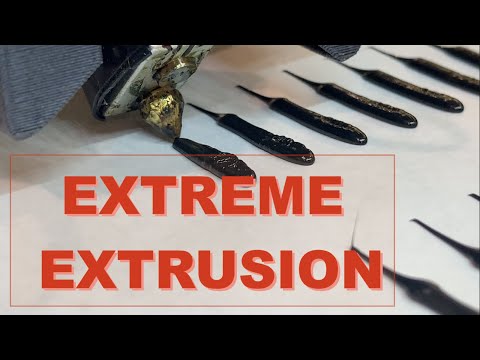After watching a CNC Kitchen video about fast benchy failures, I was inspired to run some of my own tests.
Boy would I love a technique I could use on each filament color and vendor to find the sweet spot for optimal print quality. Often there is a very large range of ‘recommended’ temperatures and but finding the right temp and right speed for good and accurate prints often takes me over 30 minutes of trial and error with multiple calibration objects.
Somewhere in those recommended temperature ranges is a spot where a .4mm nozzled machine can print well and accurately at 35-40mm/s. After an hour of calibration I once had my delta printing well at 60mm/s with specific lightly colored filament. Darker colors mean more pigment and higher temps and with speed comes thermal issues of heating the plastic fast enough.
And all this is after already making sure the bed is level and extruder is well calibrated.
The effect of out gassing during extrusion is an interesting data point I’ve never heard anyone else even mention. The latent pressure is interesting, too.
Also interesting, which I added as a note to the video afterward, is the apparent effect of a friction lock in the bowden tube that prevents further extrusion even after heat recovers. That is, until the extruder “clicks” or extrusion is paused/reversed.
but you were pushing out a MASSIVE amount of plastic and if you extrapolated the speed the effector/hotend would have to move to put that much plastic into a .5mm wide x .3mm high extrusion it would likely be beyond the capabilities of all but the best delta printers. ie, unrealistic so the fact that the heater can’t keep up is interesting but no something you’d see in the normal operation.
When people go to 1mm nozzles and 1.5 or 2mm wide extrusions then heater sizes and chamber temp really becomes an issue. Isn’t the typical speed of a Cartesian machine around 45mm/s with delta’s doing 60, 80 and even 100 mm/s?
It is pretty crazy how much effect temps and speed have on the extrusion and extrusion bonding.
I’m not sure that’s true. I do see this effect in my belt printer setup at “normal” extrusion speeds of 80-100mm/s as it transitions from a long slow line on the belt to a “faster” line up the side of an object. I have observed the temp falling behind then overshooting as it tries to compensate. And the effect on the finish of the part shows the same “expansion” of the filament at a higher temp. I don’t know how much effect the increased pressure at higher speeds/flow-rates mimics higher temperature. But there is anecdotal evidence for some contribution.
So your bowden based Creality printmill does 80-100mm/s, nice!
Are you saying that the amount of plastic you extruded to make those fat blobs is equivalent to realistic extrusions at 80-100mm/s with .4-.5mm nozzle and normal extrusion width? Looks like a ton of plastic.
The flow rate in the test was clearly higher than that. I’m only able to print at those speeds because I have heavily modified my printer. There is a post about it in Showcase.
Oh, my point was that you were extruding far more plastic than a typical 3D printer is going to extrude and therefore issues with filament jams due to the extruder heater not being able to keep up are not relatable to real world use. I think I mentioned outside cases like 1mm nozzles and 2mm wide extrusions a very few have used for large models on very large 3D printers. And then for those there are dual heater hotends like the Volcano IIRC.
At the top of the scale, that’s not really true. It just looks like a lot because the distance is shortened and the video has been sped up. The flow rate goes from “normal print” to “very fast print” top to bottom. In my testing, the extruder never “clicked”. It would have only at the higher flow rates if I had let it run longer. But it was sufficient to show the tipping point into under-extrusion, which was what I was going after.
me: “Are you saying that the amount of plastic you extruded to make those fat blobs is equivalent to realistic extrusions at 80-100mm/s with .4-.5mm nozzle and normal extrusion width? Looks like a ton of plastic.”
you: "The flow rate in the test was clearly higher than that. "
me: “Oh, my point was that you were extruding far more plastic than a typical 3D printer is going to extrude and therefore issues with filament jams due to the extruder heater not being able to keep up are not relatable to real world use.”
you: "The flow rate goes from “normal print” to “very fast print” top to bottom. "
throwing my hands up not understanding if what plastic you were extruding(flow rate) was or wasn’t typical for a normal 3D printer at normal usable speeds. Looked cool though and the angled bed exposing so much of the nozzle worked great for video purposes.
the highest flow rates in the test were higher than what you would get at 100mm/s. I made a google sheet with the baseline computations and meant to create a web-version that would generate gcode for your desired filament, temps, and speeds. but I didn’t get that far. sorry for the confusion.
for a little context, the inspiration was a video talking about the fast benchy print tests (and failures). in those scenarios, they’re pushing 200-400 mm/s, which is well within the scope of this test. for that group, this test shows something I doubt they were even looking for which could be a source of failures or other print quality issues.
